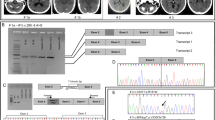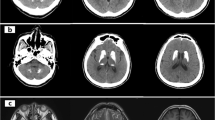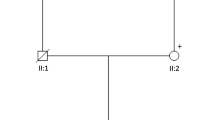Abstract
Familial idiopathic basal ganglia calcification (IBGC) or Fahr's disease is a rare neurodegenerative disorder characterized by calcium deposits in the basal ganglia and other brain regions, which is associated with neuropsychiatric and motor symptoms. Familial IBGC is genetically heterogeneous and typically transmitted in an autosomal dominant fashion. We performed a mutational analysis of SLC20A2, the first gene found to cause IBGC, to assess its genetic contribution to familial IBGC. We recruited 218 subjects from 29 IBGC-affected families of varied ancestry and collected medical history, neurological exam, and head CT scans to characterize each patient's disease status. We screened our patient cohort for mutations in SLC20A2. Twelve novel (nonsense, deletions, missense, and splice site) potentially pathogenic variants, one synonymous variant, and one previously reported mutation were identified in 13 families. Variants predicted to be deleterious cosegregated with disease in five families. Three families showed nonsegregation with clinical disease of such variants, but retrospective review of clinical and neuroimaging data strongly suggested previous misclassification. Overall, mutations in SLC20A2 account for as many as 41 % of our familial IBGC cases. Our screen in a large series expands the catalog of SLC20A2 mutations identified to date and demonstrates that mutations in SLC20A2 are a major cause of familial IBGC. Non-perfect segregation patterns of predicted deleterious variants highlight the challenges of phenotypic assessment in this condition with highly variable clinical presentation.



Similar content being viewed by others
References
Sobrido MJ, Hopfer S, Geschwind DH (2007) Familial idiopathic basal ganglia calcification. In: Pagon R, Bird T, Dolan C, (eds.) GeneReviews [Internet]. Seattle WA
Moskowitz M, Winickoff R, Heinz E (1971) Familial calcification of the basal ganglions: a metabolic and genetic study. N Engl J Med 285(2):72–77
Brodaty H, Mitchell P, Luscombe G, Kwok JJ, Badenhop RF, McKenzie R et al (2002) Familial idiopathic basal ganglia calcification (Fahr's disease) without neurological, cognitive and psychiatric symptoms is not linked to the IBGC1 locus on chromosome 14q. Hum Genet 110(1):8–14
Koller WC, Cochran JW, Klawans HL (1979) Calcification of the basal ganglia: computerized tomography and clinical correlation. Neurology 29(3):328–333
Harrington MG, Macpherson P, McIntosh WB, Allam BF, Bone I (1981) The significance of the incidental finding of basal ganglia calcification on computed tomography. J Neurol Neurosurg Psychiatry 44(12):1168–1170
Förstl H, Krumm B, Eden S, Kohlmeyer K (1991) What is the psychiatric significance of bilateral basal ganglia mineralization? Biol Psychiatry 29(8):827–833
Geschwind D, Loginov M, Stern J (1999) Identification of a locus on chromosome 14q for idiopathic basal ganglia calcification (Fahr disease). Am J Hum Genet 65(3):764–772
Volpato CBB, De Grandi A, Buffone E, Facheris M, Gebert U, Schifferle G et al (2009) 2q37 as a susceptibility locus for idiopathic basal ganglia calcification (IBGC) in a large South Tyrolean family. J Mol Neurosci 39(3):346–353
Dai X, Gao Y, Xu Z, Cui X, Liu J, Li Y et al (2010) Identification of a novel genetic locus on chromosome 8p21.1–q11.23 for idiopathic basal ganglia calcification. Am J Med Genet B Neuropsychiatr Genet 153B(7):1305–1310
Wang C, Li Y, Shi L, Ren J, Patti M, Wang T et al (2012) Mutations in SLC20A2 link familial idiopathic basal ganglia calcification with phosphate homeostasis. Nature Genetics 44:254–256
Ng PC, Henikoff S (2003) SIFT: predicting amino acid changes that affect protein function. Nucl Acids Res 31(13):3812–3814
Desmet FO, Hamroun D, Lalande M, Collod-Béroud G, Claustres M, Béroud C (2009) Human Splicing Finder: an online bioinformatics tool to predict splicing signals. Nucl Acids Res 37(9):e67
Adzhubei IA, Schmidt S, Peshkin L, Ramensky VE, Gerasimova A, Bork P et al (2010) A method and server for predicting damaging missense mutations. Nat Methods 7(4):248–249
Bøttger P, Pedersen L (2011) Mapping of the minimal inorganic phosphate transporting unit of human PiT2 suggests a structure universal to PiT-related proteins from all kingdoms of life. BMC Biochem 12(1):21
Oliveira JR, Spiteri E, Sobrido MJ, Hopfer S, Klepper J, Voit T et al (2004) Genetic heterogeneity in familial idiopathic basal ganglia calcification (Fahr disease). Neurology 63(11):2165–2167
Kostić VS, Lukić-Ječmenica M, Novaković I, Dobričić V, Brajković L, Krajinović M et al (2011) Exclusion of linkage to chromosomes 14q, 2q37 and 8p21.1–q11.23 in a Serbian family with idiopathic basal ganglia calcification. J Neurol 258(9):1637–1642
Acknowledgments
We would like to acknowledge and thank all of the participants and families for their valuable contribution to our study. This work was funded by NIH/NINDS (R01 NS040752 to DHG), CNPq (Conselho Nacional de Desenvolvimento Científico e Tecnológico to JRMO and MZ), CAPES (Coordenação de Aperfeiçoamento de Pessoal de Nível Superior to JRMO), FAPESP/CEPID (State of São Paulo Research Foundation to MZ), FACEPE (Fundação de Amparo à Ciência e Tecnologia do Estado de Pernambuco to JRMO), Australian NHMRC (program grant 510135 to PBM), Ministry of Education and Science, Republic of Serbia (grant no. 175090 to VK, MJ, VD, and IN), and NIMH (K08 MH86297 to BLF). MJS and BQ are supported by research contracts from the Institute of Health Carlos III, European Regional Development Funds (FEDER) and the Botin Foundation. JG is supported by NIH (PSO AG008702-22 to M. Shelanski).
Conflict of interest
AEL declares that he has served as an advisor for Abbott, Allon Therapeutics, Astra Zenica, Avanir Pharmaceuticals, Biovail, Boerhinger-Ingelheim, BMS Cephalon, Ceregene, Eisai, GSK, Lundbeck A/S, Medtronic, Merck Serono, MSD, Novartis, Santhera, Solvay, and Teva; received grants from Canadian Institutes of Health Research, Dystonia Medical Research Foundation, Michael J. Fox Foundation, National Parkinson Foundation, Parkinson Society of Canada, and Ontario Problem Gambling Research Centre; received publishing royalties from Saunders, Wiley-Blackwell, Johns Hopkins Press, and Cambridge University Press; and has served as an expert witness in cases related to the welding industry. All the other authors have no conflicts to disclose.
Author information
Authors and Affiliations
Corresponding authors
Rights and permissions
About this article
Cite this article
Hsu, S.C., Sears, R.L., Lemos, R.R. et al. Mutations in SLC20A2 are a major cause of familial idiopathic basal ganglia calcification. Neurogenetics 14, 11–22 (2013). https://doi.org/10.1007/s10048-012-0349-2
Received:
Accepted:
Published:
Issue Date:
DOI: https://doi.org/10.1007/s10048-012-0349-2




